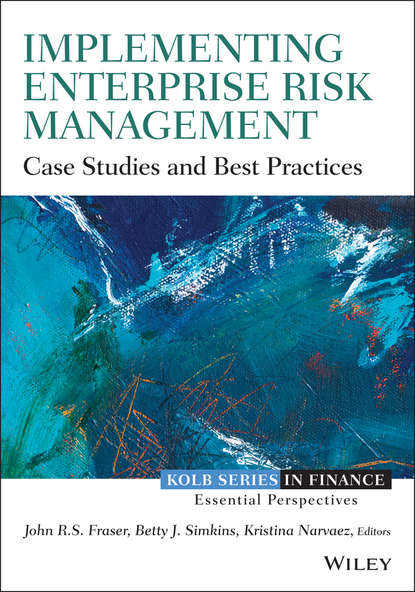"Внедрение управления предприятием рисков. Кейсы и передовые практики"
"Внедрение управления предприятием рисков" - это практическое руководство по созданию эффективной системы управления предприятием рисков (ERM) путем применения передовых практик на конкретном уровне. На основе кейсов ведущих международных организаций, включая Mars, Statoil, LEGO, British Columbia Lottery Corporation и Astro, автор иллюстрирует реальное внедрение ERM на макроуровне, а также объясняет, как ERM влияет на реагирование на конкретные инциденты. Читатели узнают, как ведущие компании эффективно строят системы ERM для стимулирования финансового роста и управления операционными и внешними рисками. Автор обсуждает вызовы, связанные с внедрением ERM в крупных организациях с различными структурными подразделениями и установленными процессами, и предоставляет экспертное мнение о том, как внедрить новую систему в культуру, негативно относящуюся к изменениям.
Управление предприятием рисков охватывает случайные потери, а также финансовые, стратегические, операционные и другие риски. Недавняя экономическая и финансовая волатильность вызвала повышенный интерес к ERM, и регуляторы и инвесторы начали внимательно изучать политику и процедуры управления рисками компаний. "Внедрение управления предприятием рисков" предоставляет ясные и практические инструкции по созданию сильной и эффективной системы. Читатели узнают, как:
- Сформировать правильные команды для создания прочной структуры ERM.
- Внедрить систему ERM в условиях культурных, логистических и исторических преград.
- Создать общий язык и систему отчетности для передачи ключевых показателей риска.
- Сформировать рискосознательную культуру без подавления полезных рисковых поведений.
ERM - это сложное дело, требующее экспертного планирования, организации и лидерства с целью направления деятельности компании таким образом, чтобы минимизировать влияние рисков на финансовую стоимость и результативность. Корпоративные правления все чаще требуют проверки и отчетности об адекватности ERM в организациях, которыми они управляют, и "Внедрение управления предприятием рисков" предлагает практическое руководство по созданию программы, которая успешно пройдет проверку.
Overcome ERM Implementation Challenges by Learning from Leading Global Organizations Implementing Enterprise Risk Management explains how to install an effective Enterprise Risk Management (ERM) program. It does this by showing how best practice can be applied in specific projects from around the globe.
Using case studies of real organizations like Mars Inc., Statoil ASA, LEGO Group, the British Columbia Lottery, and Astro, the book shows how ERM management really plays out. This should provide you with many useful guidelines on how to ensure that an ERM program leads to positive financial growth, managing the various risks associated with running a business.
Many large organizations find it challenging to adopt an ERM approach. You will get expert advice on dealing with these challenges, demonstrating how individuals from different parts of large and entrenched organizations can adapt and contribute to building an ERM solution.
ERM manages not only financial losses, but also more insidious hazards like frauds, regulatory compliance problems, supply chain incidents, etc. The stress on efficient risk mitigation in businesses has led federal authorities and businesses capitalists all over the world to require organisations to expose their actual and potential risks.
Электронная Книга «Implementing Enterprise Risk Management. Case Studies and Best Practices» написана автором John Fraser в году.
Минимальный возраст читателя: 0
Язык: Английский
ISBN: 9781118745762
Описание книги от John Fraser
Overcome ERM implementation challenges by taking cues from leading global organizations Implementing Enterprise Risk Management is a practical guide to establishing an effective ERM system by applying best practices at a granular level. Case studies of leading organizations including Mars, Statoil, LEGO, British Columbia Lottery Corporation, and Astro illustrate the real-world implementation of ERM on a macro level, while also addressing how ERM informs the response to specific incidents. Readers will learn how top companies are effectively constructing ERM systems to positively drive financial growth and manage operational and outside risk factors. By addressing the challenges of adopting ERM in large organizations with different functioning silos and well-established processes, this guide provides expert insight into fitting the new framework into cultures resistant to change. Enterprise risk management covers accidental losses as well as financial, strategic, operational, and other risks. Recent economic and financial market volatility has fueled a heightened interest in ERM, and regulators and investors have begun to scrutinize companies' risk-management policies and procedures. Implementing Enterprise Risk Management provides clear, demonstrative instruction on establishing a strong, effective system. Readers will learn to: Put the right people in the right places to build a strong ERM framework Establish an ERM system in the face of cultural, logistical, and historical challenges Create a common language and reporting system for communicating key risk indicators Create a risk-aware culture without discouraging beneficial risk-taking behaviors ERM is a complex endeavor, requiring expert planning, organization, and leadership, with the goal of steering a company's activities in a direction that minimizes the effects of risk on financial value and performance. Corporate boards are increasingly required to review and report on the adequacy of ERM in the organizations they administer, and Implementing Enterprise Risk Management offers operative guidance for creating a program that will pass muster.



















